LTE NB NTN (Non Terrestrial Network)
This tutorial is to show you how to configure and test LTE NB NTN. NTN (Non Terrestrial Network) is a type of network deployment in which some type of non-terrestrial (e.g, satellite or other airborne component). Overall protocol sequence of NTN is not much different from the existing LTE RAN access (LTE NB, LTE, NR), but one major difference is to handle the long propagation delay between the ground components (eNB and/or DUT) and Satellite. There are two major components introduced in 3GPP as listed below.
- Additional SIBs : This is mainly to inform the position of Satellite (i.e, ephemeris) and default time delay. In LTE case, the SIB31 carries these information.
- Additional MAC CE : These are mainly to handle the long time delay. The MAC CE "Differential Koffset" is introduced for PDSCH and "Timing Advanced Report" for PUSCH.
There are various different type of NTN deployment in 3GPP TR 36.763. Currently Amarisoft NTN implementation is as shown below.
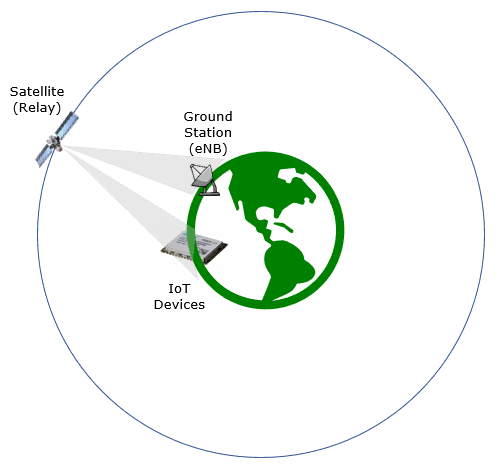
Table of Contents
- LTE NB NTN (Non Terrestrial Network)
Introduction
LTE NB NTN (Narrowband Internet of Things for Non-Terrestrial Networks) is an advanced extension of the LTE (Long Term Evolution) architecture designed to enable reliable connectivity between terrestrial and non-terrestrial components, such as satellites or airborne platforms. As defined by 3GPP standards, NTN provides coverage in areas where traditional terrestrial networks are insufficient or unavailable, leveraging satellite-based communication to extend the reach of cellular IoT services. The key architectural enhancement in LTE NB NTN, compared to conventional LTE RAN (Radio Access Network) access, lies in its ability to manage the significantly longer propagation delays introduced by the satellite link between ground-based entities (such as eNBs and devices) and the non-terrestrial relay. To accommodate these unique challenges, the 3GPP architecture introduces additional System Information Blocks (SIBs)—specifically SIB31 for ephemeris data and default delay parameters—and specialized MAC Control Elements (MAC CEs) such as Differential Koffset and Timing Advance Report, which are essential for robust scheduling and synchronization over long-delay links. The technology is especially relevant for mission-critical IoT, remote monitoring, and global asset tracking scenarios, where persistent connectivity across vast and remote geographic regions is required. This tutorial focuses on the configuration and testing of LTE NB-based NTN, utilizing Amarisoft's implementation as per 3GPP TR 36.763, and highlights the unique deployment considerations, protocol adaptations, and operational recommendations necessary for successful NTN integration.
-
Context and Background
- LTE NB NTN integrates satellite or airborne network components with terrestrial LTE infrastructure, enabling IoT connectivity in remote and underserved regions.
- 3GPP introduced specific protocol adaptations for NTN, such as additional SIBs (notably SIB31) and MAC CEs, to address satellite communication challenges like long propagation delay and dynamic satellite positioning.
- The Amarisoft implementation referenced in this tutorial is based on 3GPP TR 36.763 and supports the latest protocol enhancements for LTE NB NTN as of the 2023-04-21 release.
-
Relevance and Importance
- NTN technology is vital for extending IoT and M2M (Machine-to-Machine) services to global, rural, and maritime environments where terrestrial networks cannot reach.
- Understanding and configuring LTE NB NTN is essential for network operators, engineers, and developers aiming to deploy commercial and mission-critical IoT solutions over satellite links.
- The tutorial addresses real-world deployment scenarios, protocol differences from conventional LTE, and practical considerations for long-delay link management.
-
Tutorial Learning Outcomes
- Gain a comprehensive understanding of LTE NB NTN architecture and the technical challenges of integrating non-terrestrial components.
- Learn how to configure Amarisoft-based LTE NB NTN setups, including SIB and MAC CE parameterization for satellite communication.
- Develop troubleshooting and testing skills for validating NTN deployments and ensuring robust, low-latency IoT connectivity over satellite links.
-
Prerequisite Knowledge and Skills
- Familiarity with LTE and LTE NB-IoT fundamentals, including protocol stack, RAN concepts, and system information broadcasting.
- Understanding of basic satellite communication principles, such as propagation delay and ephemeris data.
- Prior experience with Amarisoft LTE test environments is recommended for practical configuration and testing exercises.
- Access to hardware and software supporting at least the 2023-04-21 Amarisoft release is required for hands-on implementation.
Summary of the Tutorial
This tutorial outlines test procedures for evaluating NTN (Non-Terrestrial Network) functionality using Amarisoft eNB and UEsim, as well as commercial UEs. The procedures focus on low-layer testing, involving simulated GEO satellite scenarios and various UE configurations. Below is a summary of the main test setups and methodologies described in the tutorial.
-
Test Setup:
- Utilizes SIM cards provided with the system.
- Supports configuration changes via a separate Configuration Guide.
- Test configurations accommodate both Amarisoft UEsim and commercial UE devices.
- Key configuration parameters for the eNB and UE are detailed, including satellite ephemeris, ground position, doppler compensation, and channel simulation parameters.
-
Test 1: NTN with Simulated GEO and UEsim
- Configuration:
- Uses
enb-nbiot-ntn.cfg(from Amarisoft release 2023-04-21) for the eNB. - Uses
mme-ims.cfgandue_db-ims.cfgfor MME, as provided. - Configures UEsim with
ue-nbiot-ntn.cfgunless a commercial UE is used (in which case, ensure support for UE-assistance-information for release-preference). - Configuration screenshots demonstrate parameter setups for all nodes.
- Uses
- Test Execution Steps:
- Run LTE service on the callbox and verify cell status using the 'cell' command.
- Optionally enable BCCH logging for a few seconds to capture SIB messages, then disable it.
- Start trace logging on the callbox.
- Power on the UE (either UEsim or commercial device).
- Wait for the UE to complete initial attach to the network.
- Log Analysis:
- Analyze the collected logs to verify correct NTN signaling and attach procedures.
- Configuration:
-
Test 2: NTN with Simulated GEO and Commercial UE in non-NTN band
- Configuration:
- Uses
enb-nbiot-ntn-Quectel.cfgfor the eNB. - Uses
mme-ims.cfgandue_db-ims.cfgas provided for MME. - Configuration screenshots illustrate the required parameter settings.
- Uses
- Test Execution Steps:
- Run LTE service on the callbox and confirm 'cell' status.
- Optionally enable BCCH logging at startup to collect SIB messages, then disable it.
- Start trace logging.
- Configure the commercial DUT as required and power it on.
- Wait for the DUT to complete initial attach to the network.
- Log Analysis:
- Review log snapshots to confirm NTN-related procedures and successful network access.
- Configuration:
-
Test 3: NTN with Simulated GEO and Commercial UE in NTN band
- Device Info:
- Device: Quectel CC660D-LS with specific firmware versions detailed in the tutorial.
- Configuration:
- Uses
enb-nbiot-ntn-geo-CC660D.cfgfor the eNB. - Uses
mme-ims.cfgandue_db-ims.cfgas provided for MME. - Configuration screenshots provide guidance on required settings.
- Uses
- Test Execution Steps:
- Optionally enable BCCH logging for brief SIB message capture, then disable it.
- Start trace logging.
- Configure the DUT using AT commands (example sequences provided in the tutorial), including GNSS info and data session activation.
- Power on the DUT and wait for initial network attach and IP assignment.
- Log Analysis:
- Analyze trace logs to verify correct NTN signaling and attach behavior on the commercial UE.
- Device Info:
-
General Notes & FAQ Highlights:
- Channel simulator usage is essential for MEO/LEO scenarios due to larger delay and Doppler variation, and optional for GEO.
- The Amarisoft channel simulator supports delay simulation up to approximately 1118 seconds for NB-IoT (based on sample rate).
- Altitude parameters can be set from -1000m to 20km, allowing for locations below sea level.
The procedures focus on configuration, step-by-step execution, and post-test log analysis to confirm correct operation of NTN features under different simulated satellite conditions and UE types. Screenshots and AT command sequences are provided to guide actual setup and execution, ensuring repeatability and clarity for practitioners.
Test Setup
Test setup for this tutorial is as shown below. This is just for low layer testing, you may not need any complicated IP layer setup.
- SIM Card used in this tutorial is the one delivered with the system as it is.
- If you want to change the configuration, The tutorial Configuration Guide would help
With Amarisoft eNB and UEsim, we can try with following two different setups.
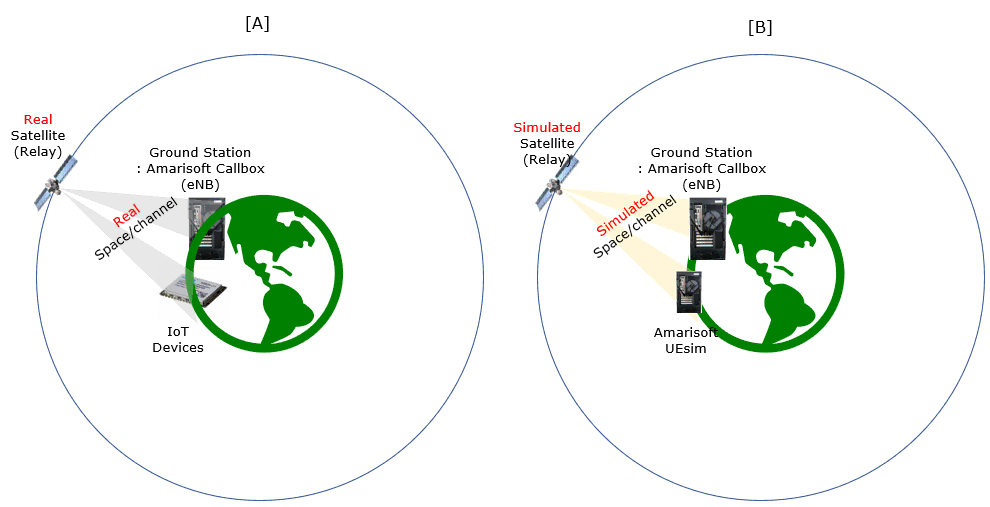
Key Configuration Parameters
Followings are important configuration parameters for this tutorial. You may click on the items for the descriptions from Amarisoft documents.
- ntn : In this link, you can find the descriptions for all the parameters below.
- ephemeris
- use_state_vectors
- eci_reference
- ground_position
- n_ta_common
- n_ta_drift
- n_ta_drift_var
- n_ta_common_offset
- feeder_doppler_compensation
- feeder_dl_freq
- feeder_ul_freq
- large_freq_shift
- direct_to_cell
- channel_sim_control
- type
- ue_position
- ue_doppler_shift
- ue_dl_freq
- ue_ul_freq
- feeder_doppler_shift
- ue_dl_attenuation
- ue_dl_gain_offset
- ul_sync_validity
- k_offset
- k_mac
- dynamic_k_offset
- reference_location
- t_service
- neighbour_cells
- rat_type
- t318
Test 1 : NTN with Simulated GEO and UEsim
Configuration
The configuration shown here is common configuration for all the subtests belonging to Test 1 and I will not show this configuration repeatedly for every subtest.
I have used enb-nbiot-ntn.cfg which is included in the installation package from the release 2023-04-21.

I am using mme-ims.cfg and ue_db-ims.cfg as they are.
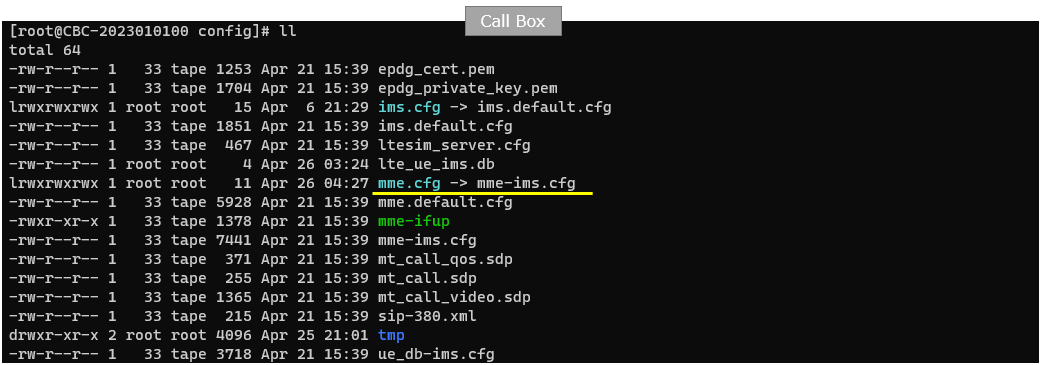
On UEsim, I used ue-nbiot-ntn.cfg which is included in the installation package from the release 2023-04-21. (

enb-nbiot-ntn.cfg is configured as follows.


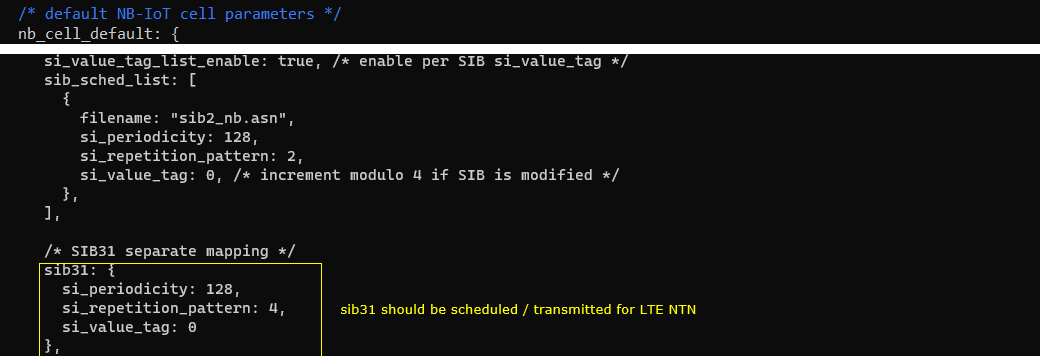
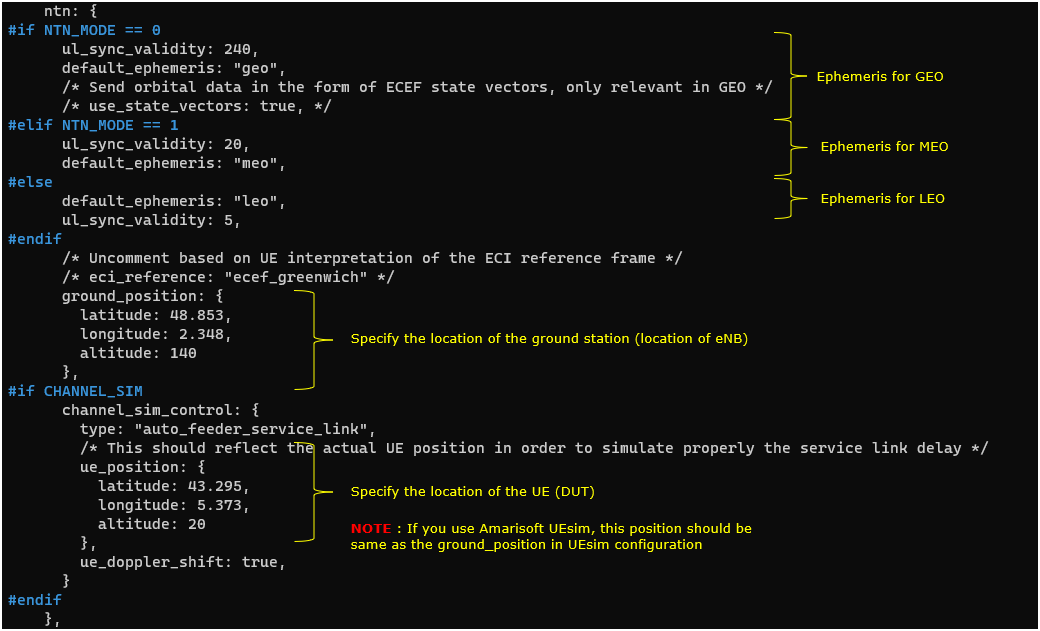

mme-ims.cfg is configured as follows :
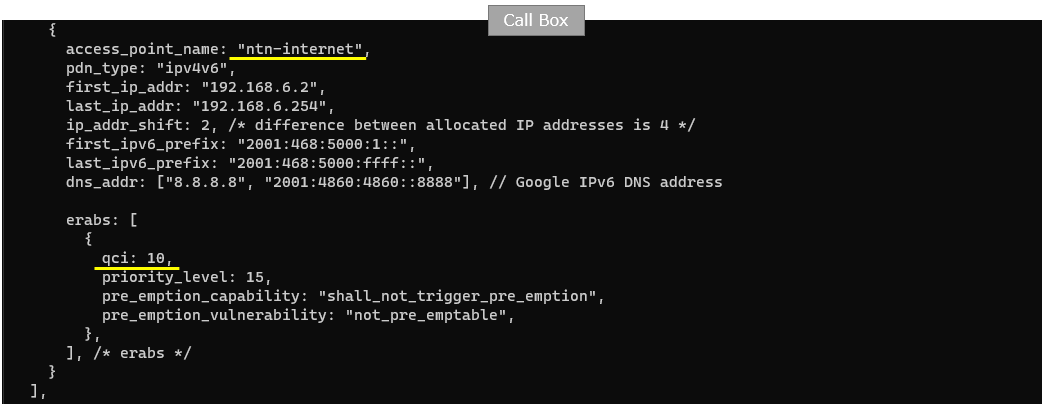
ue-nbiot-ntn.cfg is configured as shown below. (
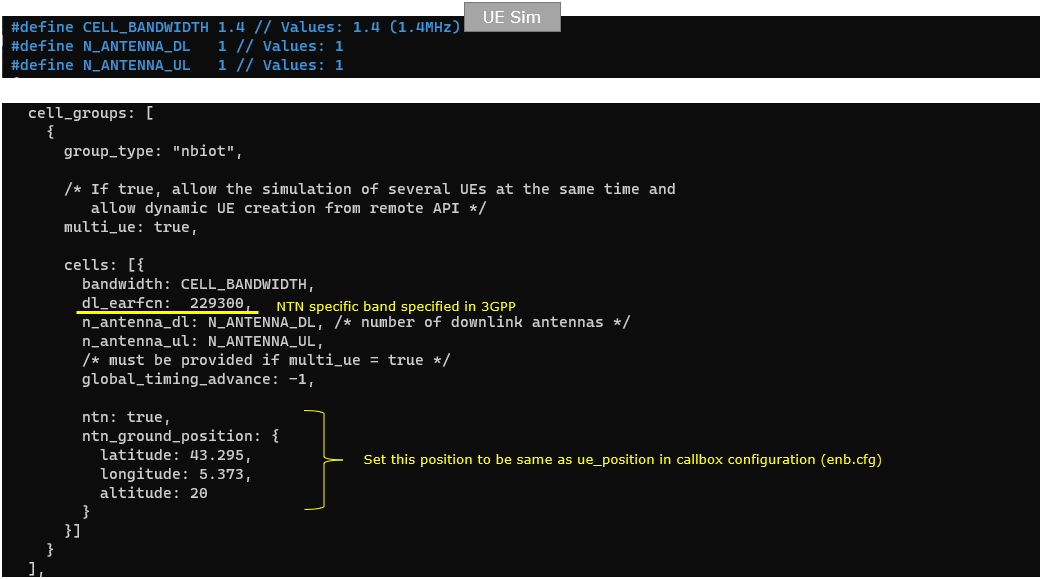
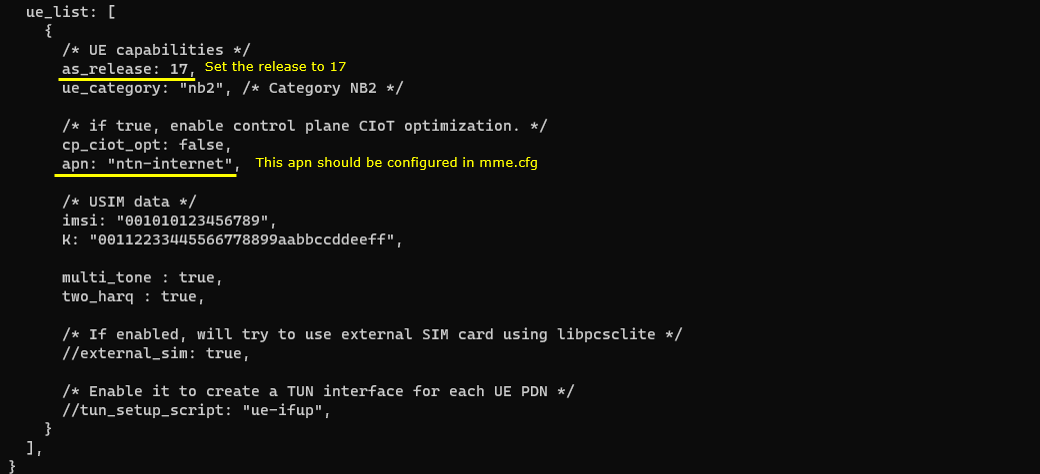
Perform the Test
Run lte service on callbox and check 'cell' command.

This is not the mandatory process.. but I did this to collect SIB message in the log for a few seconds at the beginning. I did bcch=1 and after a few seconds did bcch=0.
![]()
Now start trace logging.
![]()
Power on UE on UEsim (If your DUT is a commercial phone, turn on the phone)

Wait until the DUT complete the initial attach.

Log Analysis
Following is the log snapshot that are involved in communication with NTN.
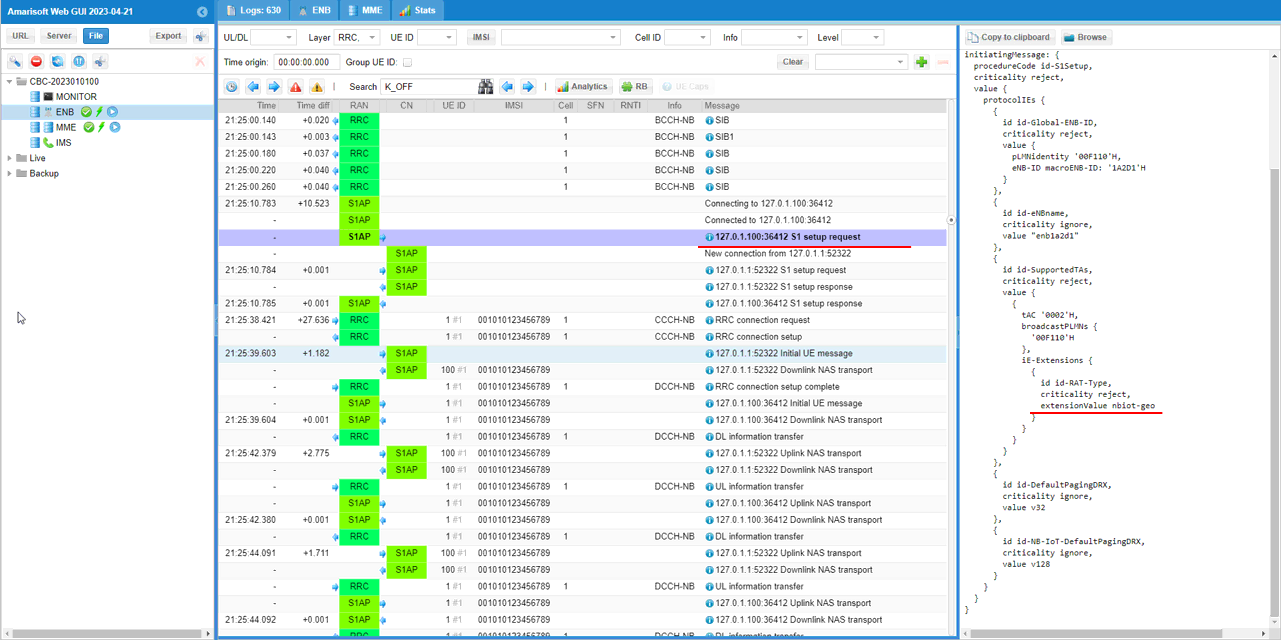
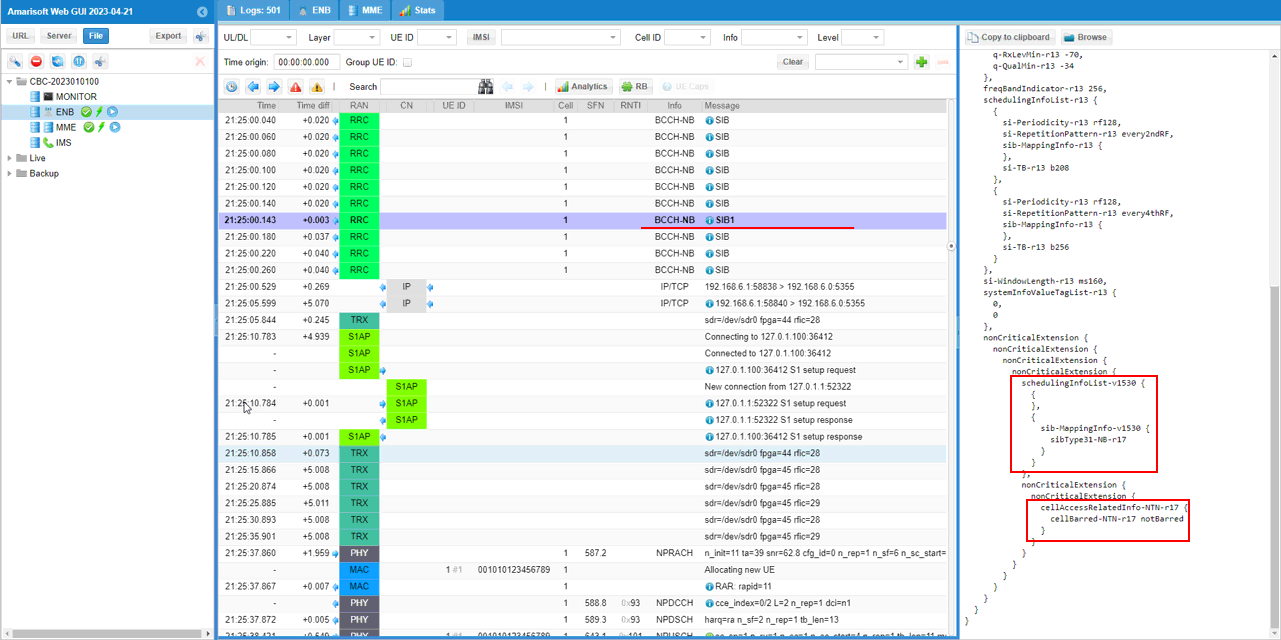
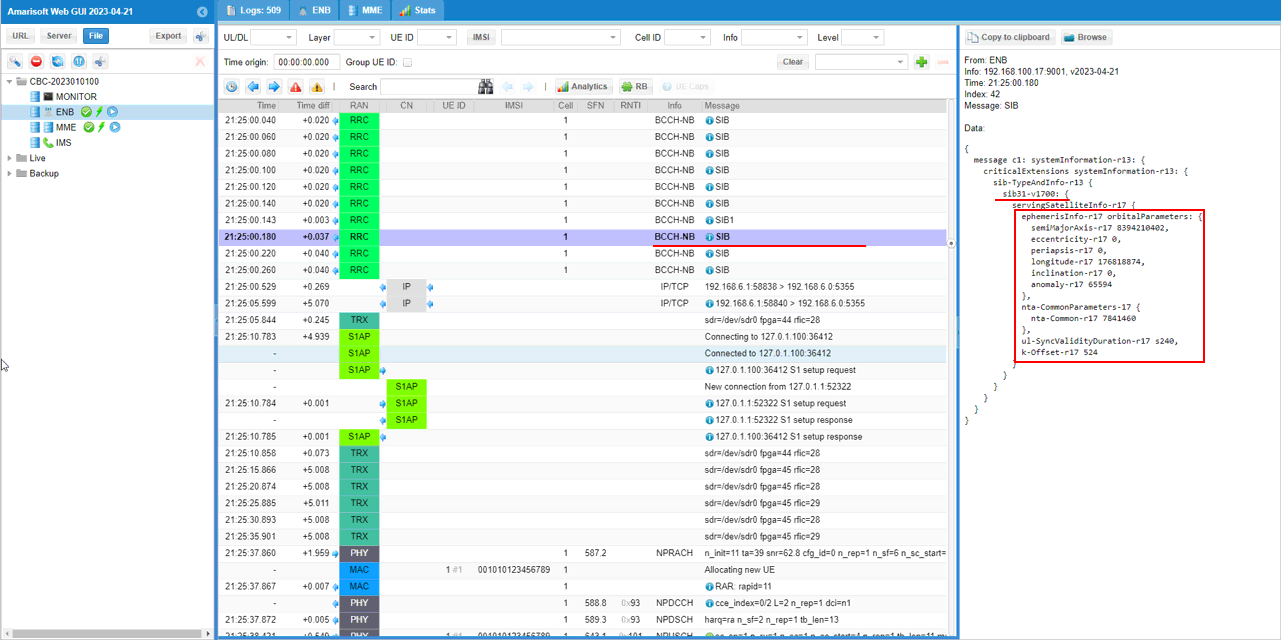
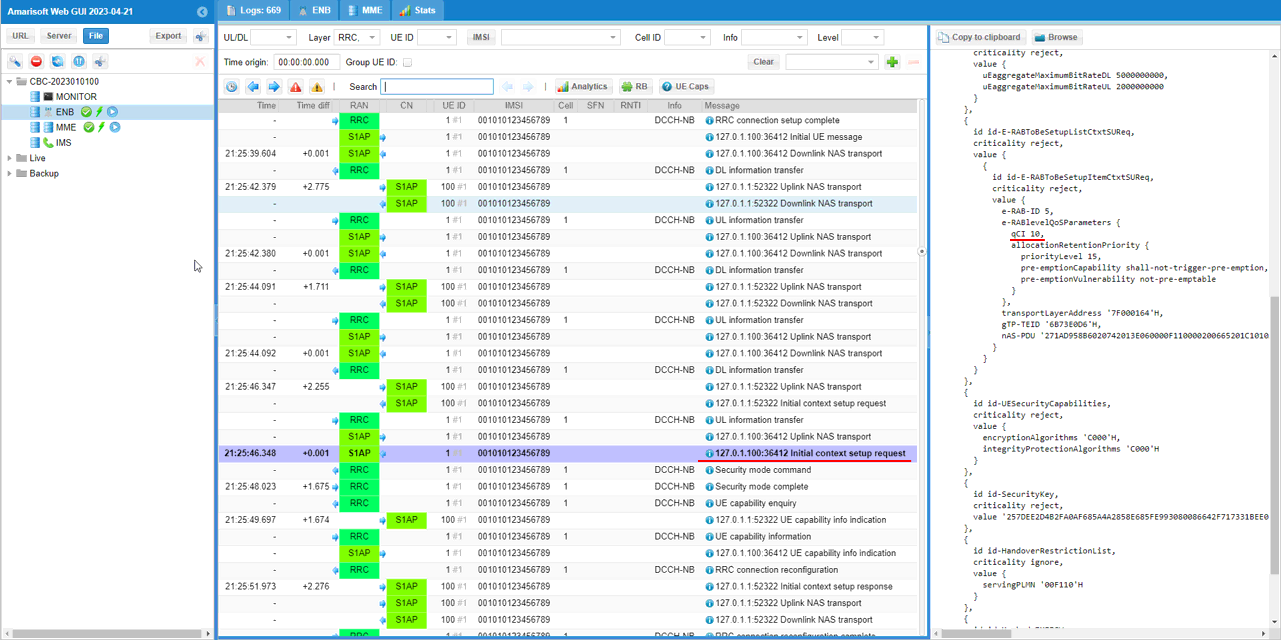
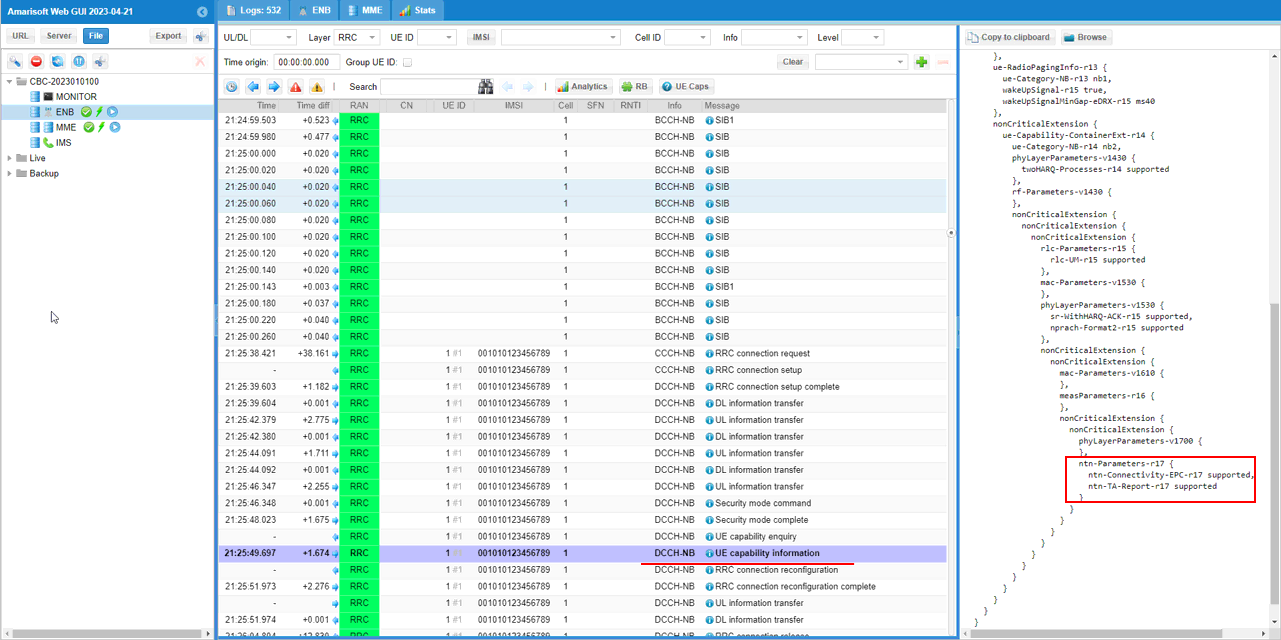
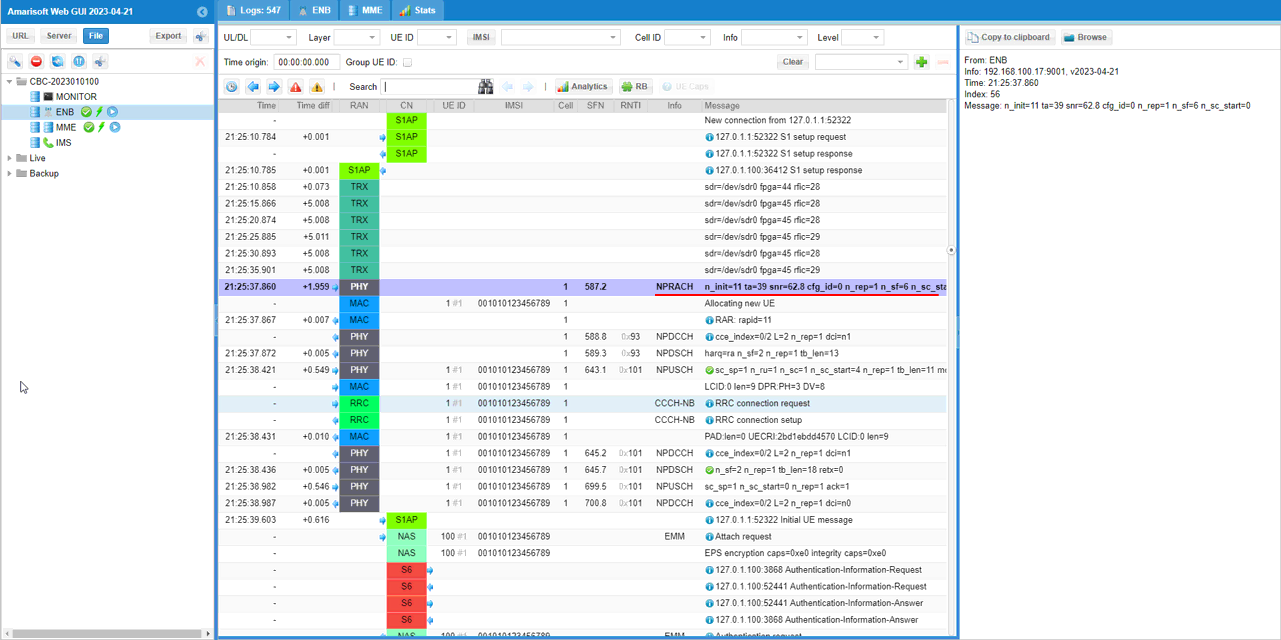
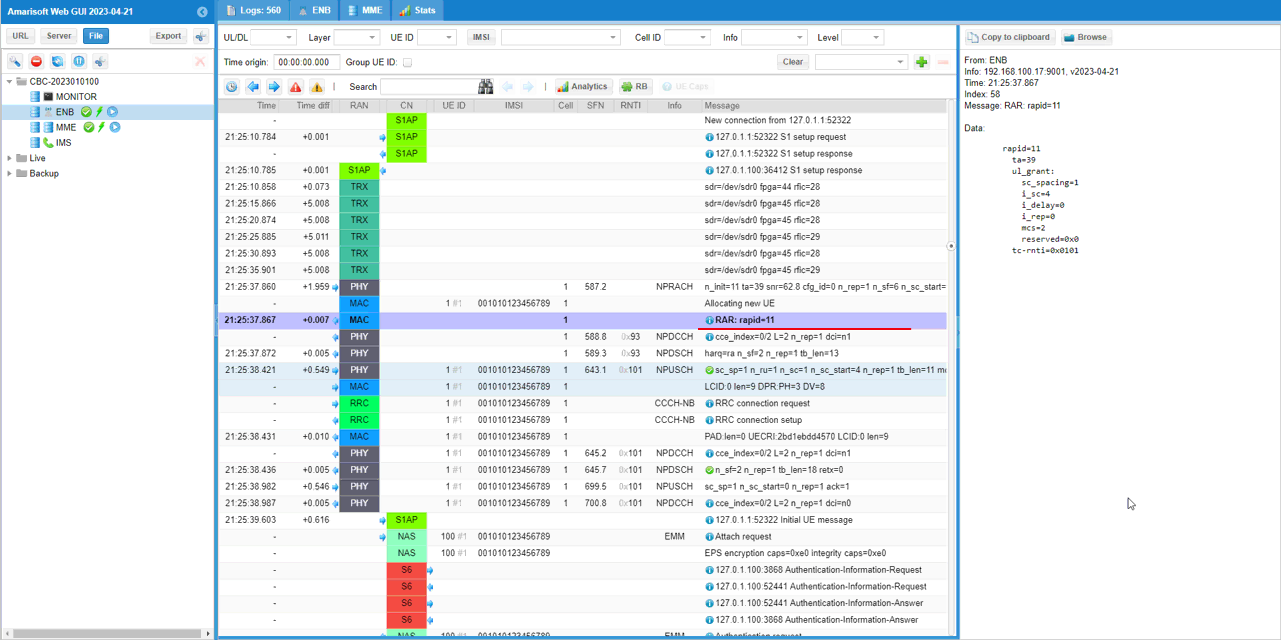
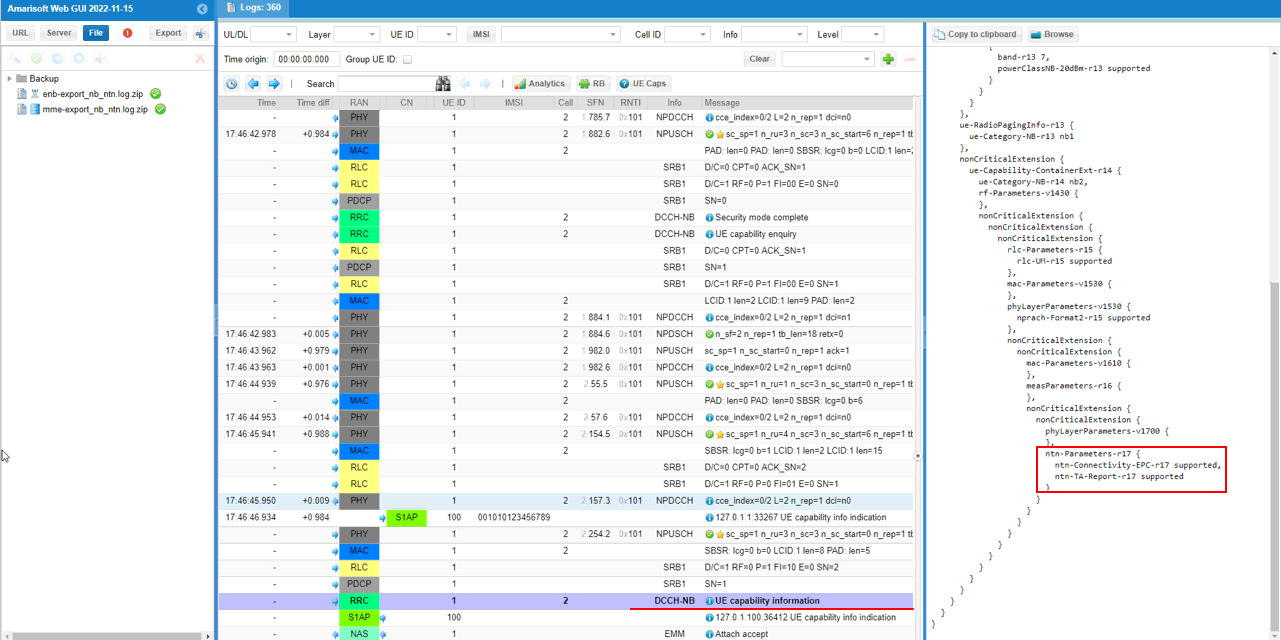
Test 2 : NTN with Simulated GEO and Commercial UE in non-NTN band
This test is with a commercial UE from Quectel: BG770-GL-TE-A. Quectel support was needed for NTN upgrade
Configuration
The configuration shown here is common configuration for all the subtests belonging to Test 1 and I will not show this configuration repeatedly for every subtest.
I have used enb-nbiot-ntn-Quectel.cfg

I am using mme-ims.cfg and ue_db-ims.cfg as they are.

enb-nbiot-ntn-Quectel.cfg is configured as follows.

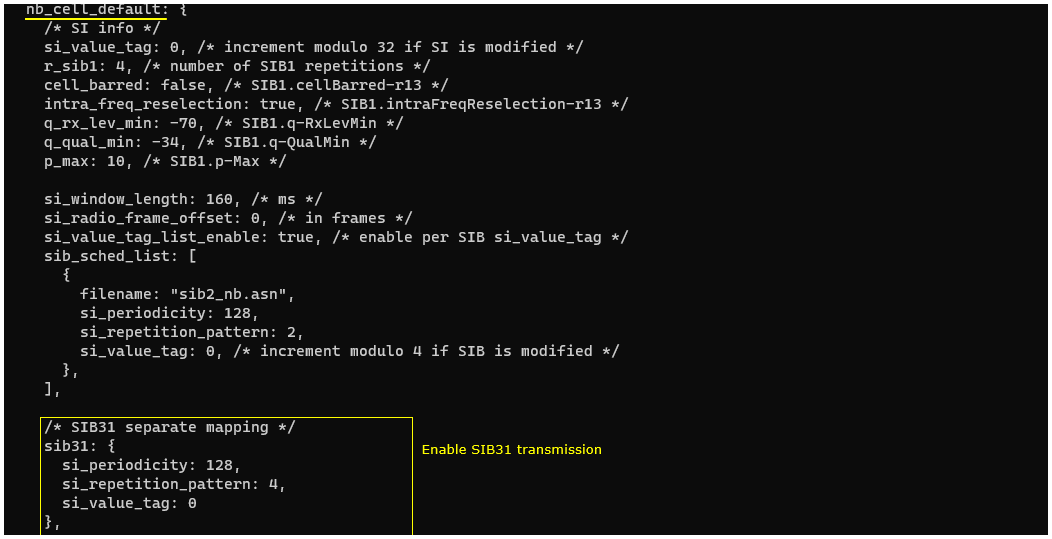
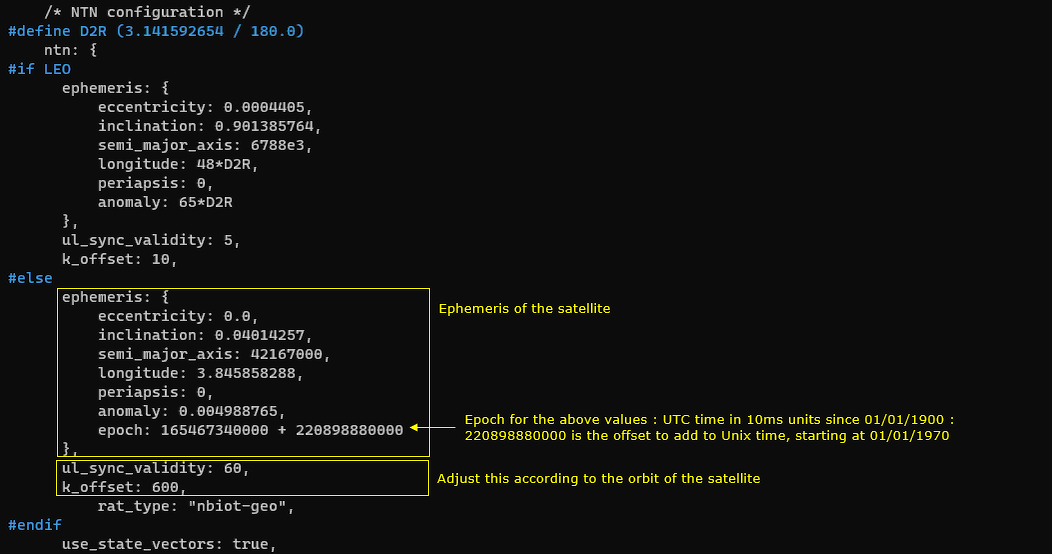

![]()

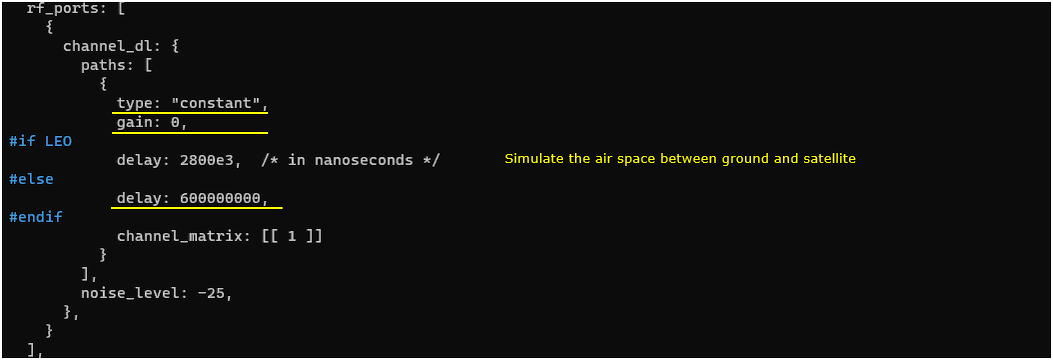
Perform the Test
Run lte service on callbox and check 'cell' command.

This is not the mandatory process.. but I did this to collect SIB message in the log for a few seconds at the beginning. I did bcch=1 and after a few seconds did bcch=0.
![]()
Now start trace logging.
![]()
Configure on DUT side and power it on.
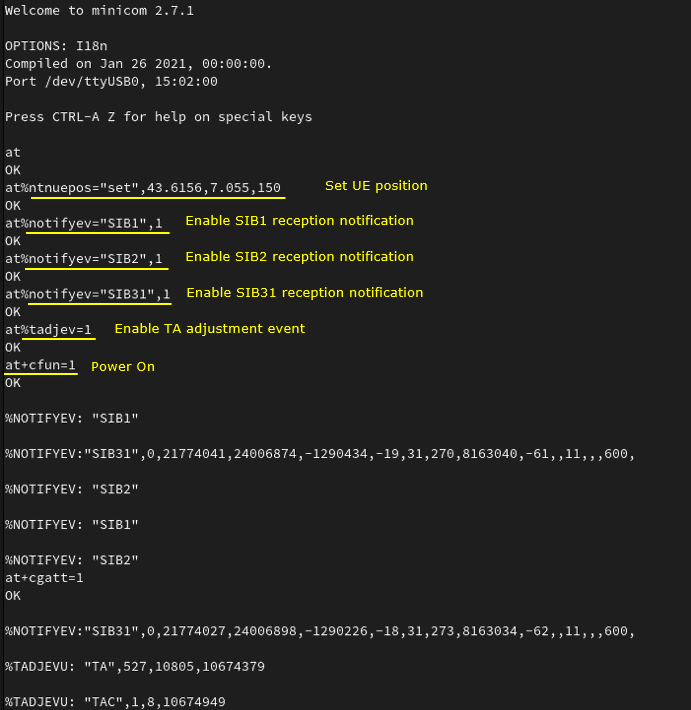
Wait until the DUT complete the initial attach.
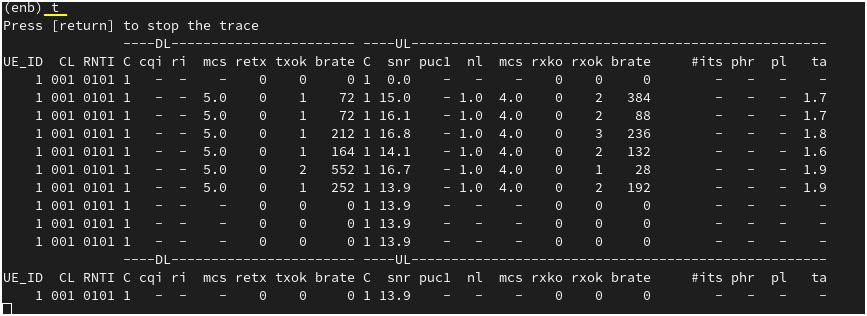
Log Analysis
Following is the log snapshot that are involved in communication with NTN.
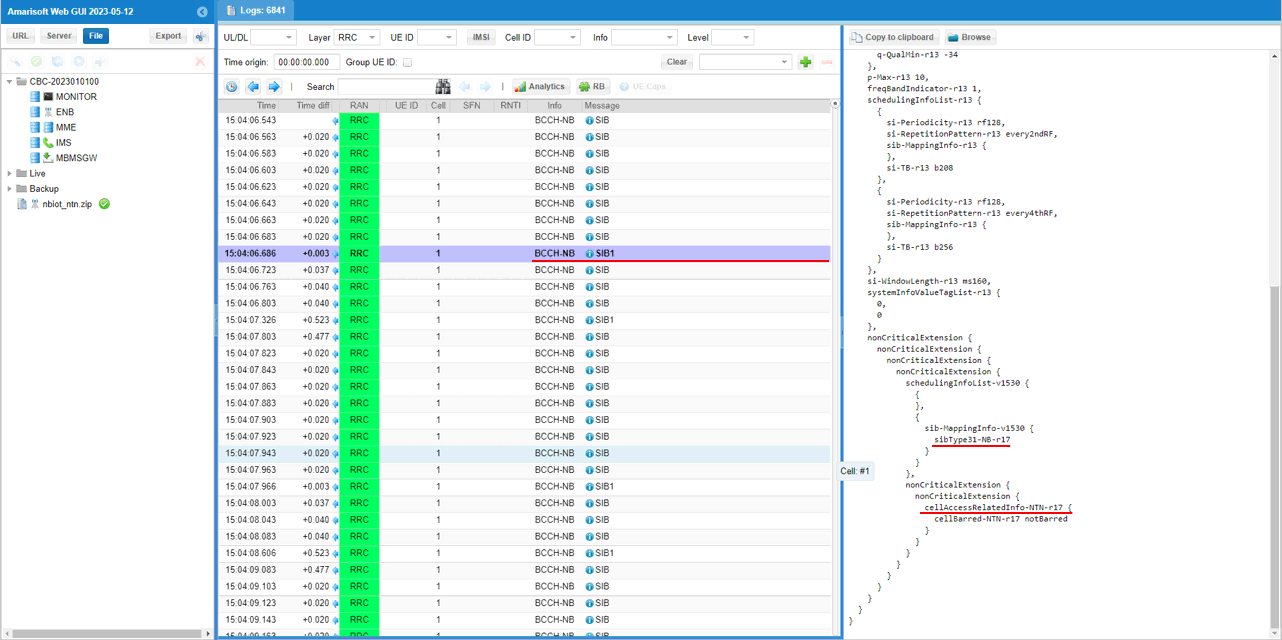
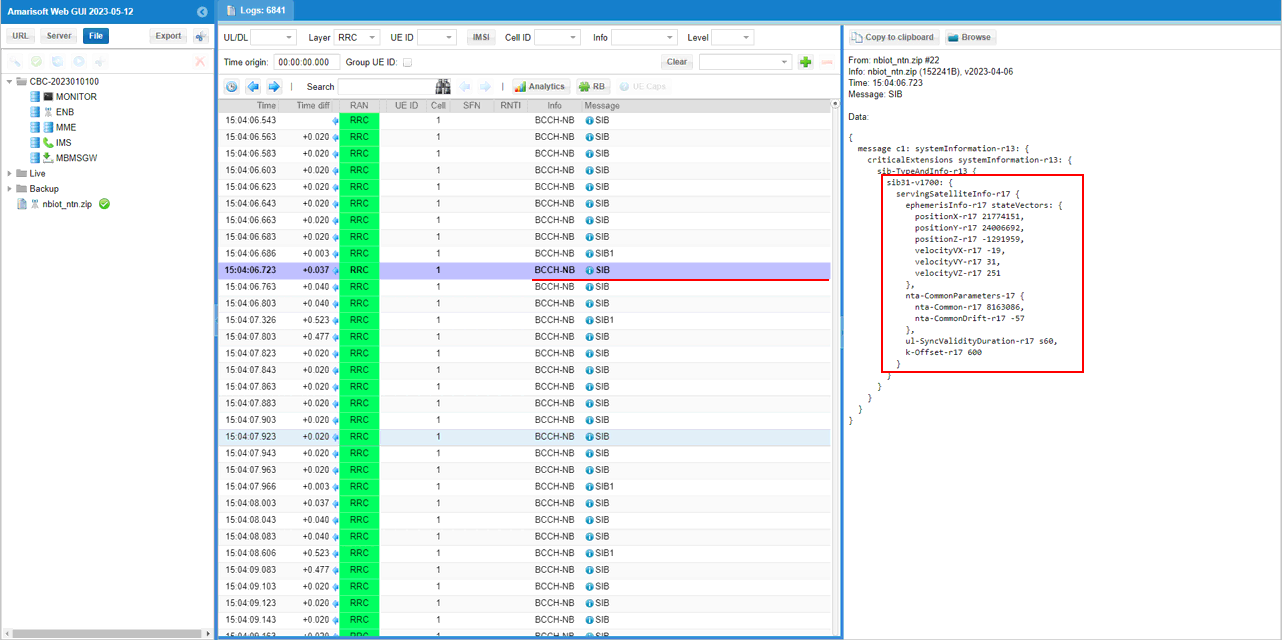
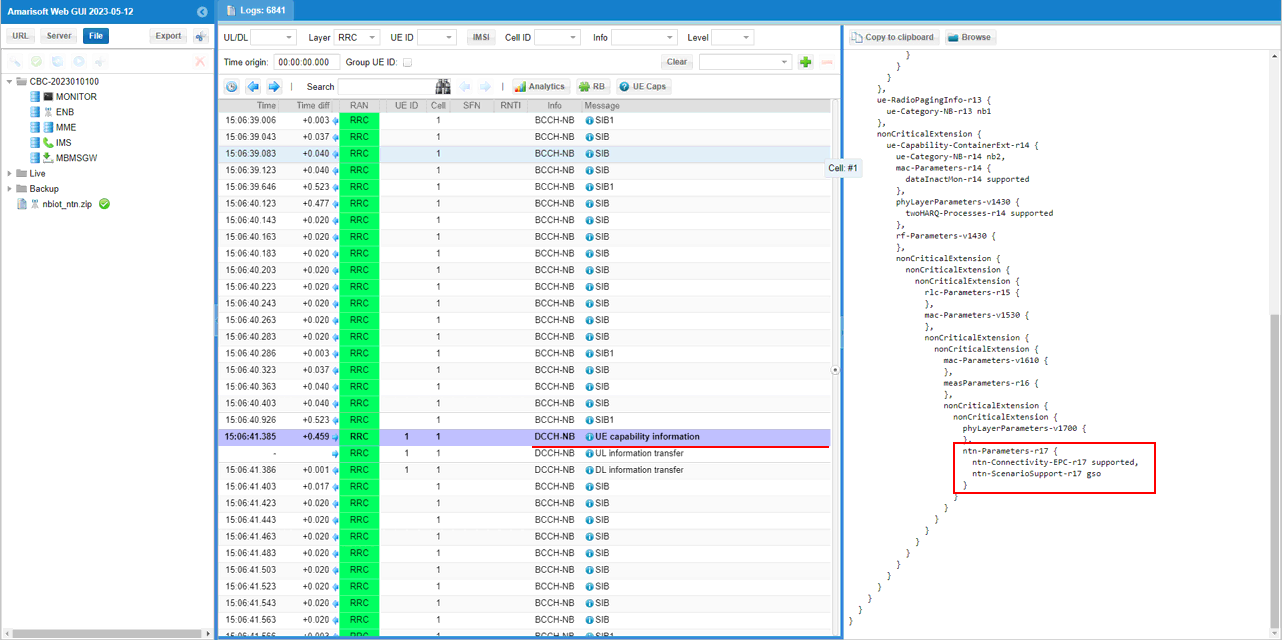
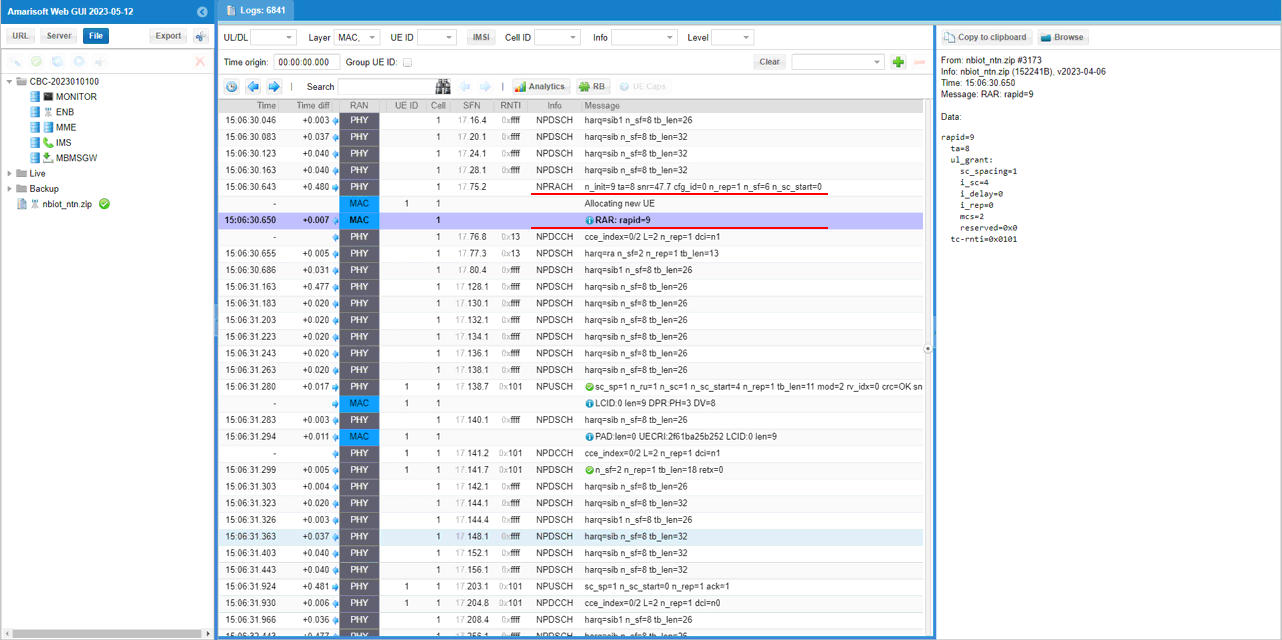
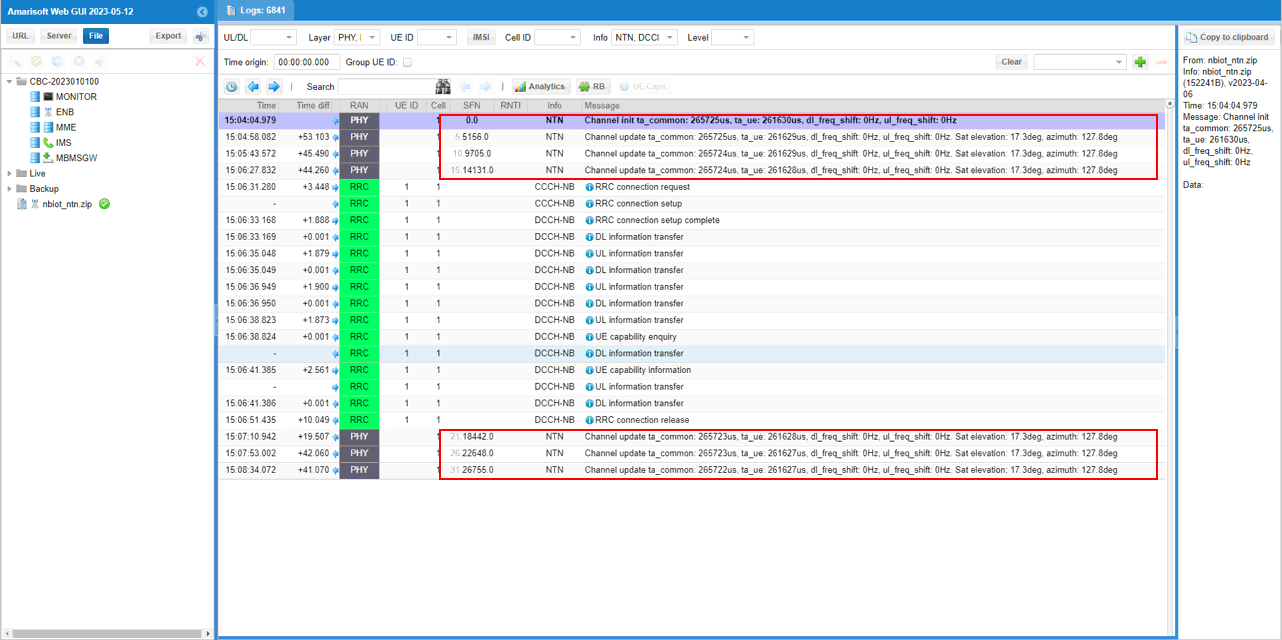
Test 3 : NTN with Simulated GEO and Commercial UE in NTN band
This test is with a commercial UE from Quectel: CC660D-LS
Device Info
The information of the specific device and firmware information that was used in this test is as follows :
|
Quectel CC660D-LS
Firmware version: Quectel_Ltd Quectel_CC660D-LS Revision: CC660DLSAAR01A02 |
Configuration
The configuration shown here is common configuration for all the subtests belonging to Test 1 and I will not show this configuration repeatedly for every subtest.
I have used enb-nbiot-ntn-geo-CC660D.cfg

I am using mme-ims.cfg and ue_db-ims.cfg as they are.

enb-nbiot-ntn-geo-CC660D.cfg is configured as follows.


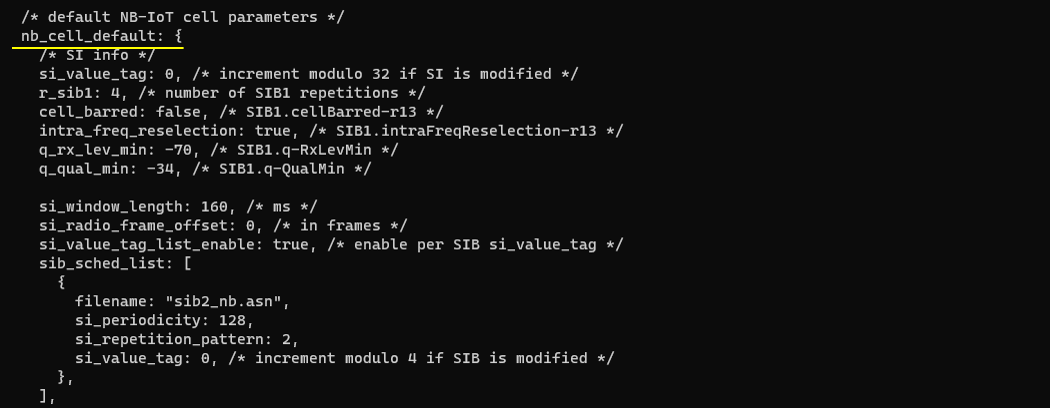
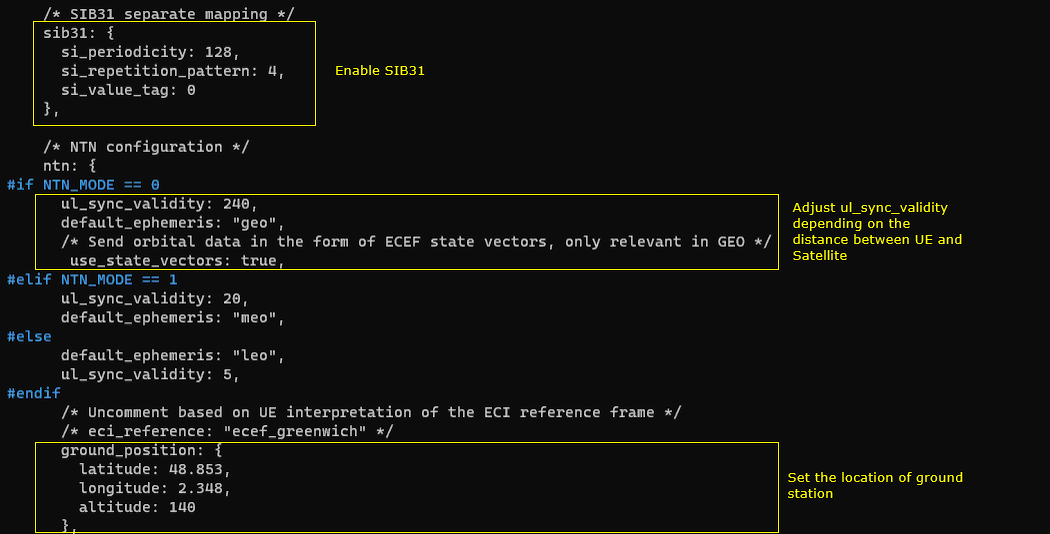
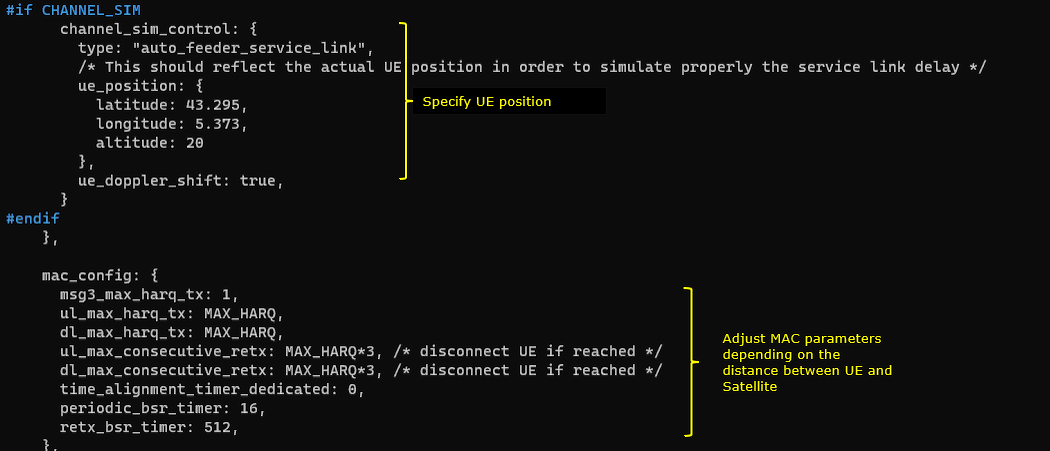

Perform the Test
This is not the mandatory process.. but I did this to collect SIB message in the log for a few seconds at the beginning. I did bcch=1 and after a few seconds did bcch=0.
![]()
Now start trace logging.
![]()
Configure on DUT side and power it on.
|
AT+QGNSSINFO=43.295,5.373,20,0,100
+QGNSSINFO: 1
at+cgact=1,1 AT+QGNSSINFO=43.295,5.373,20,0,100
OK +QGNSSINFO: 0
at+cfun=1 OK
at+cgact=1,1
+CEREG: 1,"0002","01A2D101",9,0,0,"11100000","11100000" at+cgact=1,1
+IP: 192.168.2.2 |
Wait until the DUT complete the initial attach.
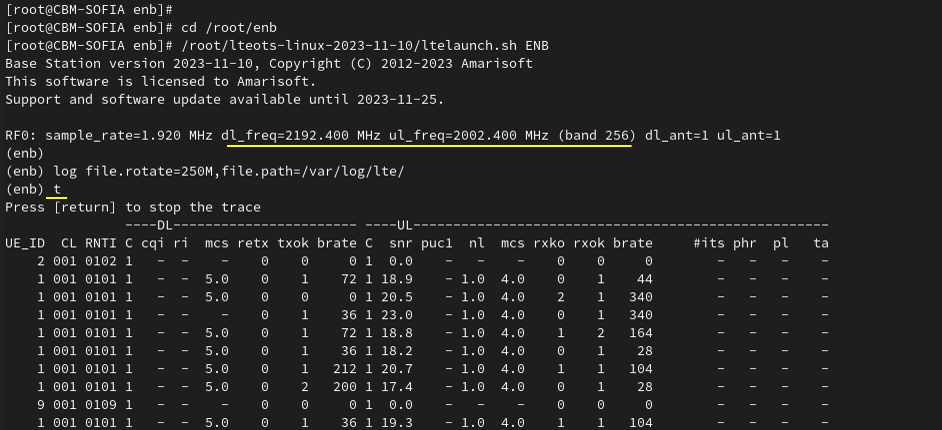
Log Analysis
Following is the log snapshot that are involved in communication with NTN.
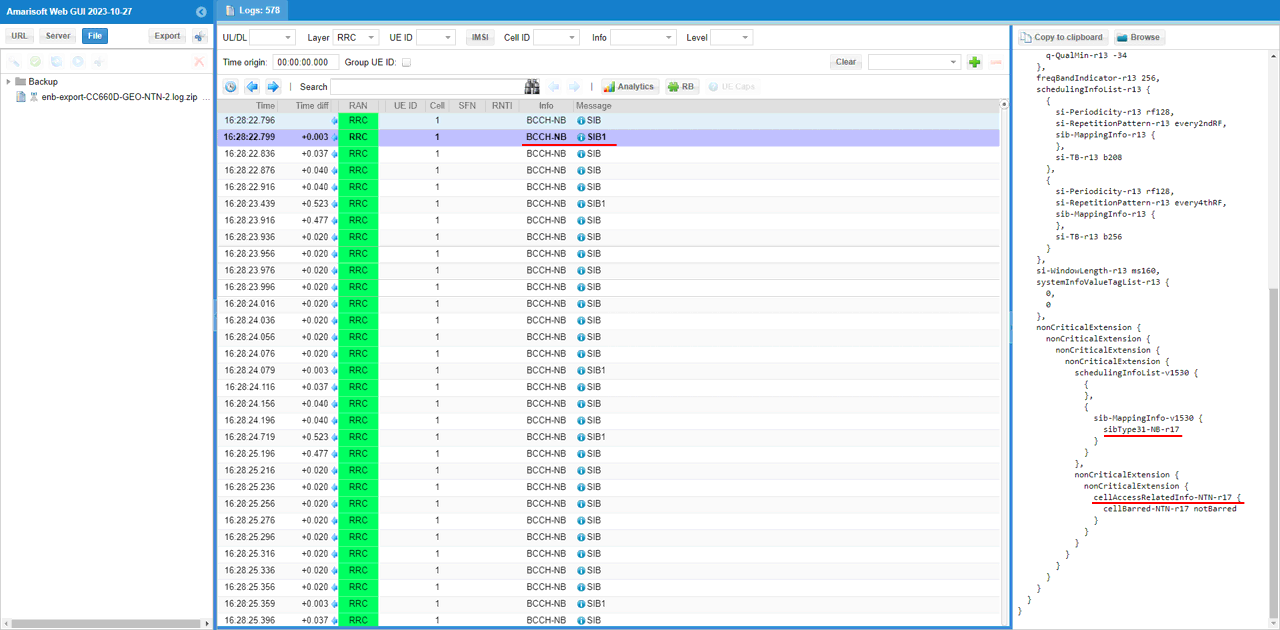
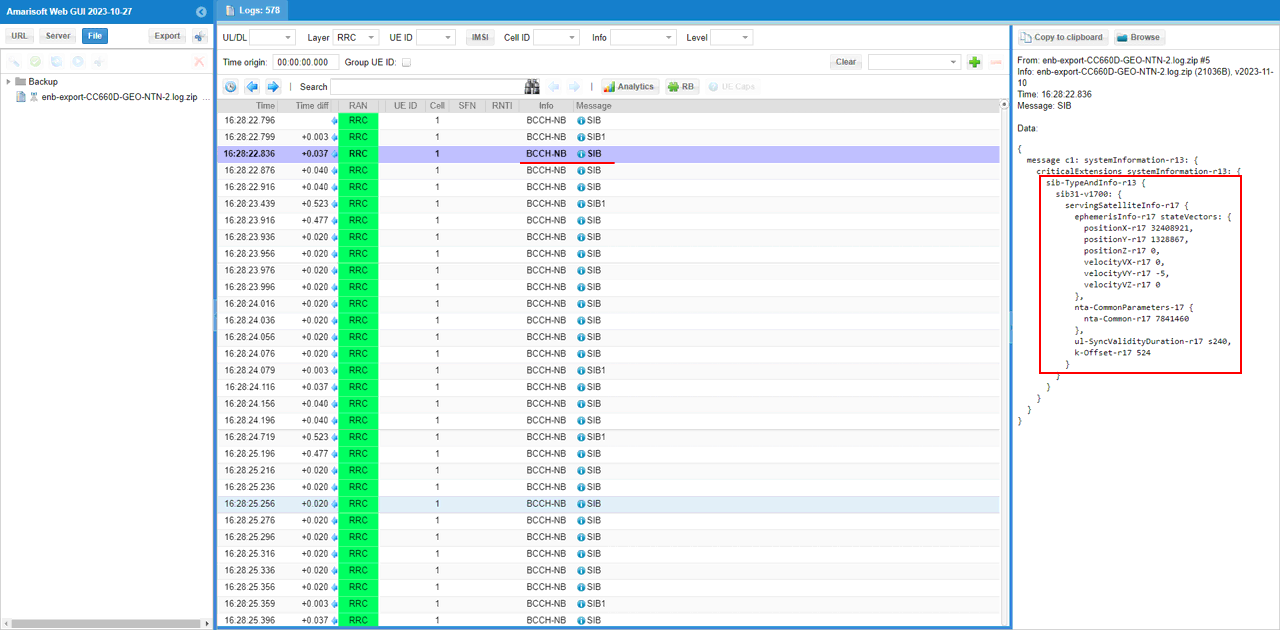
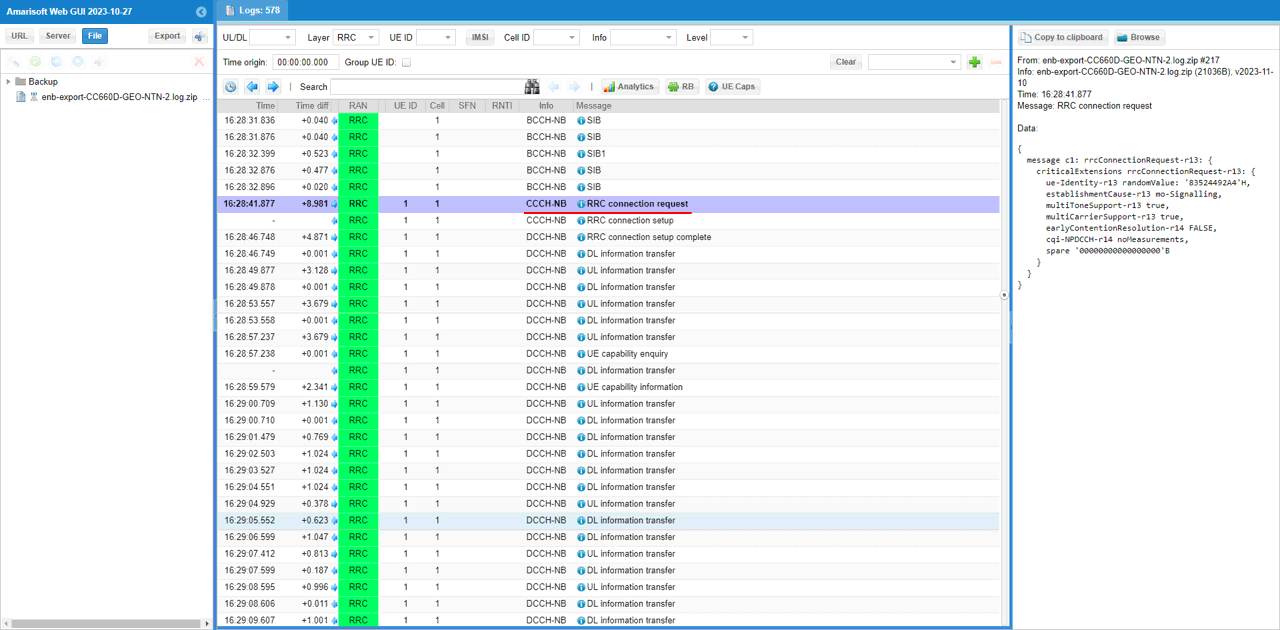
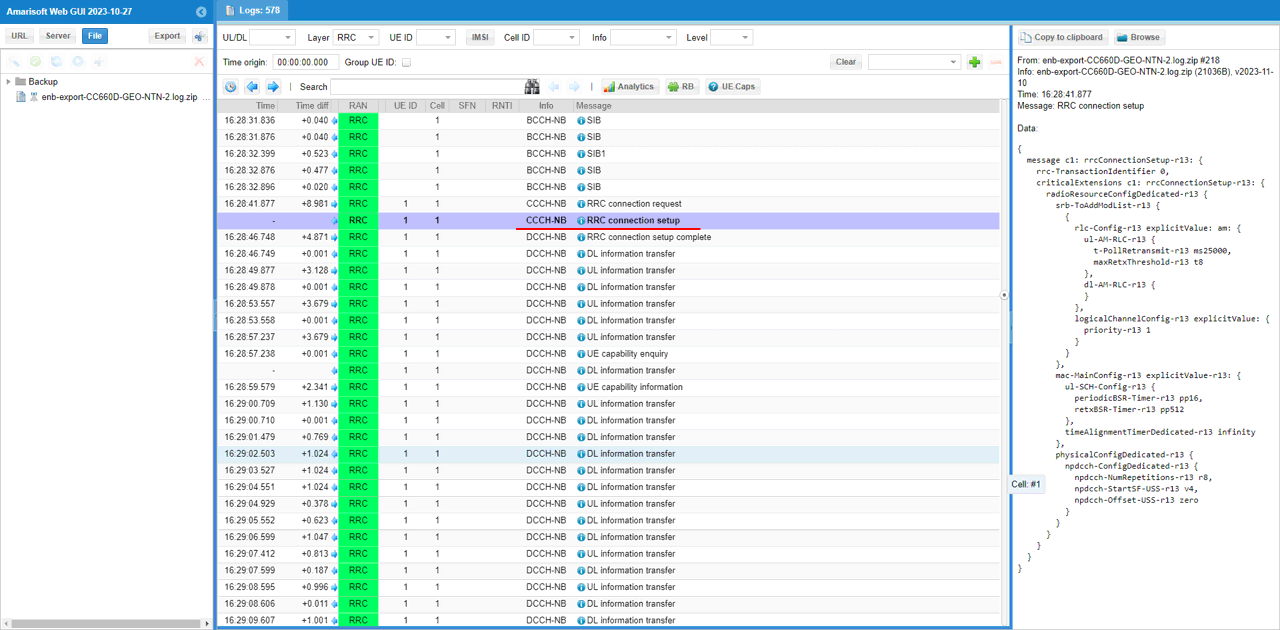
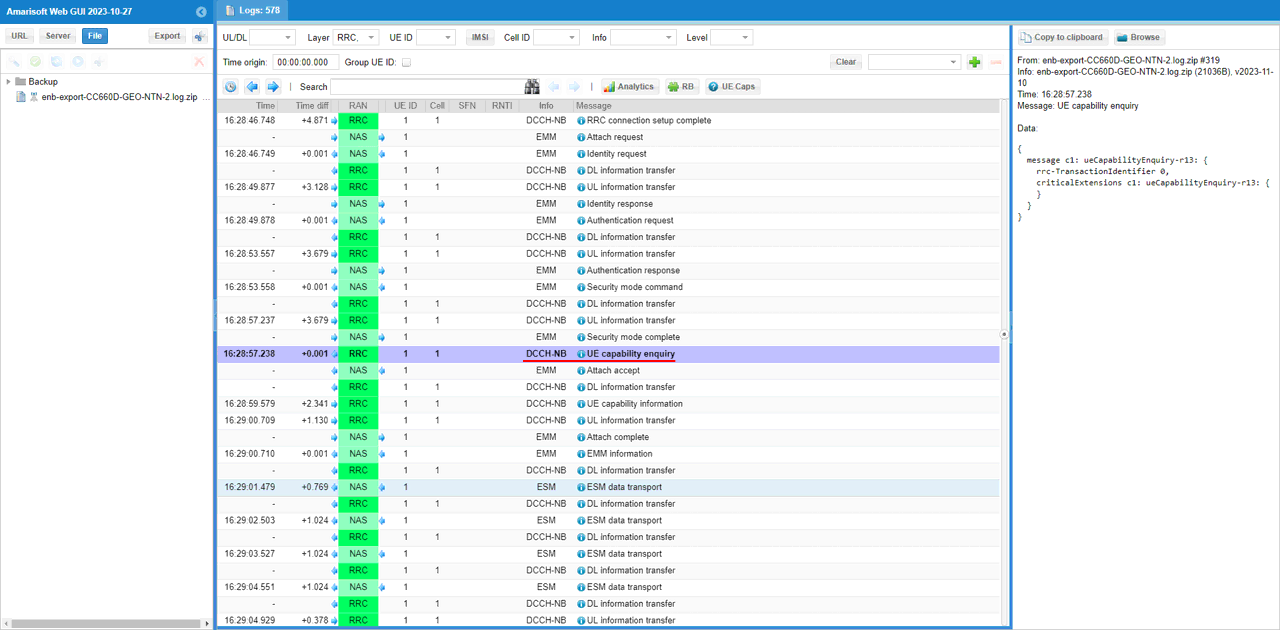
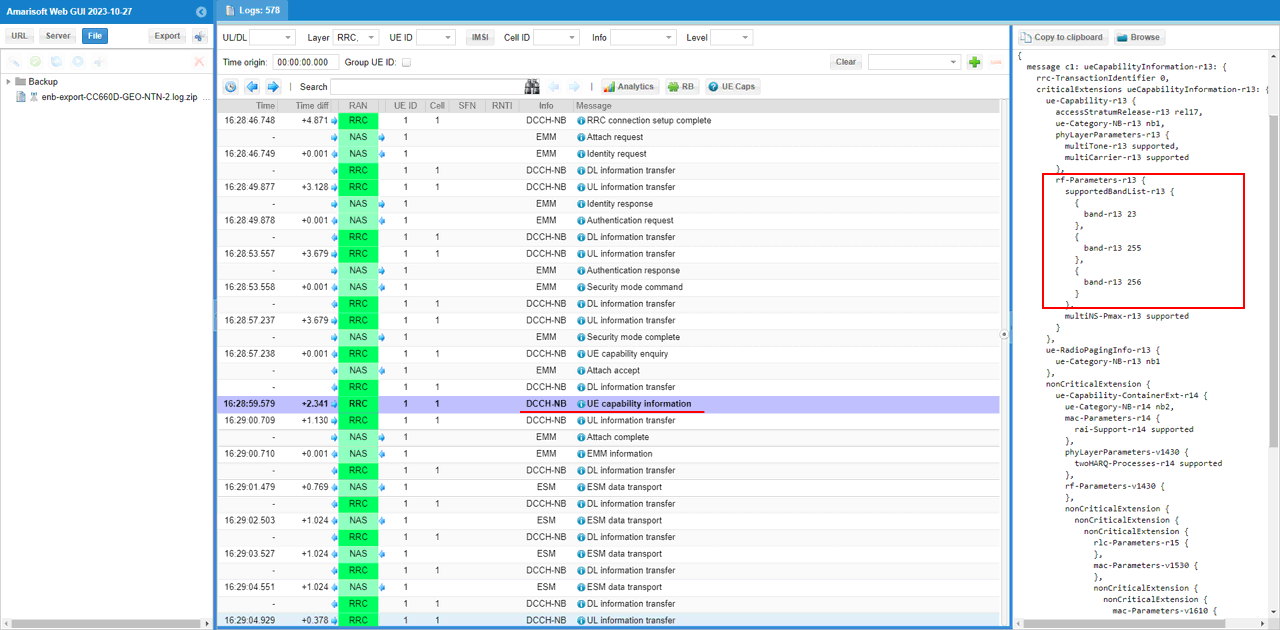
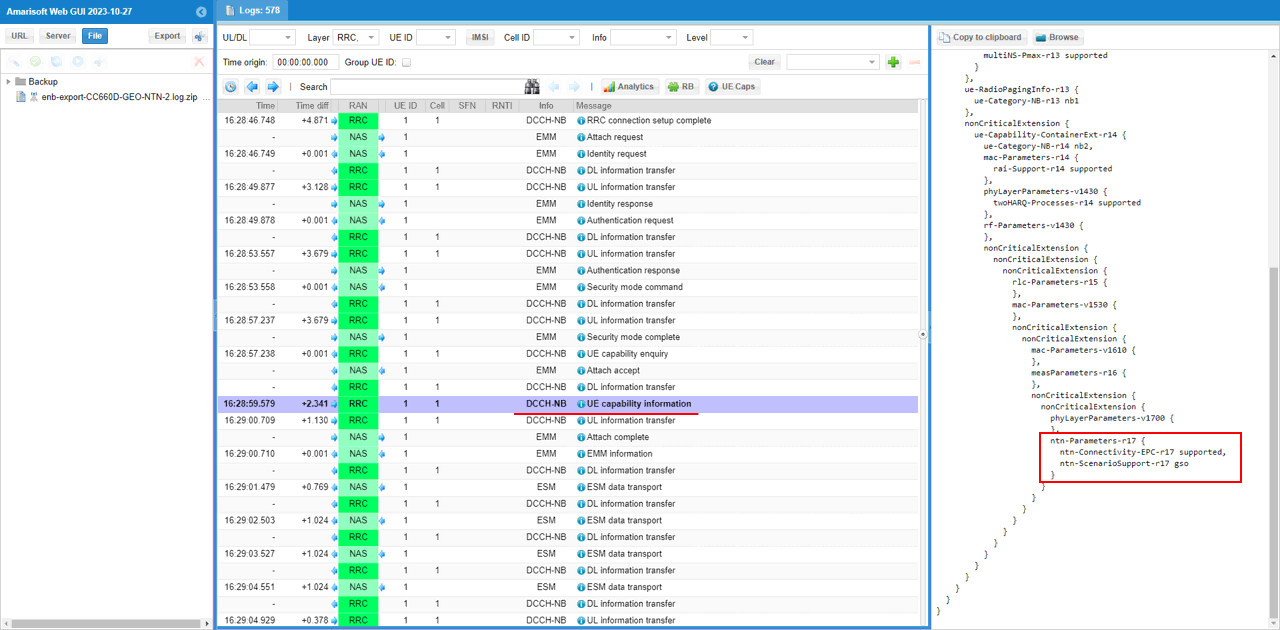
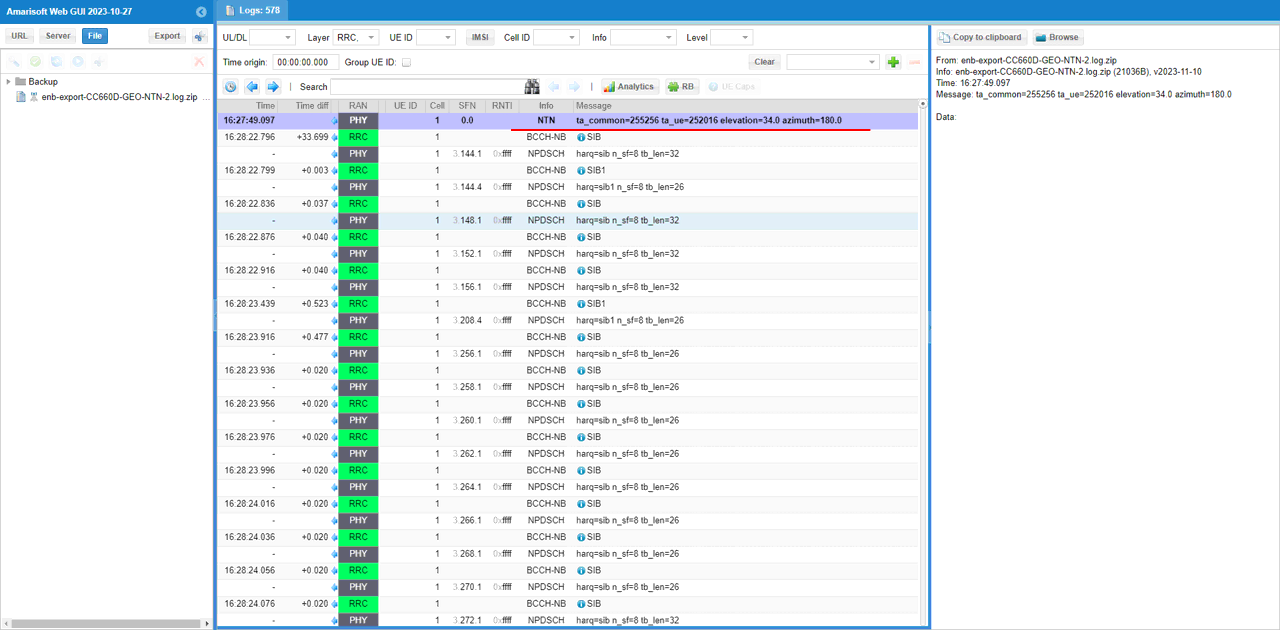
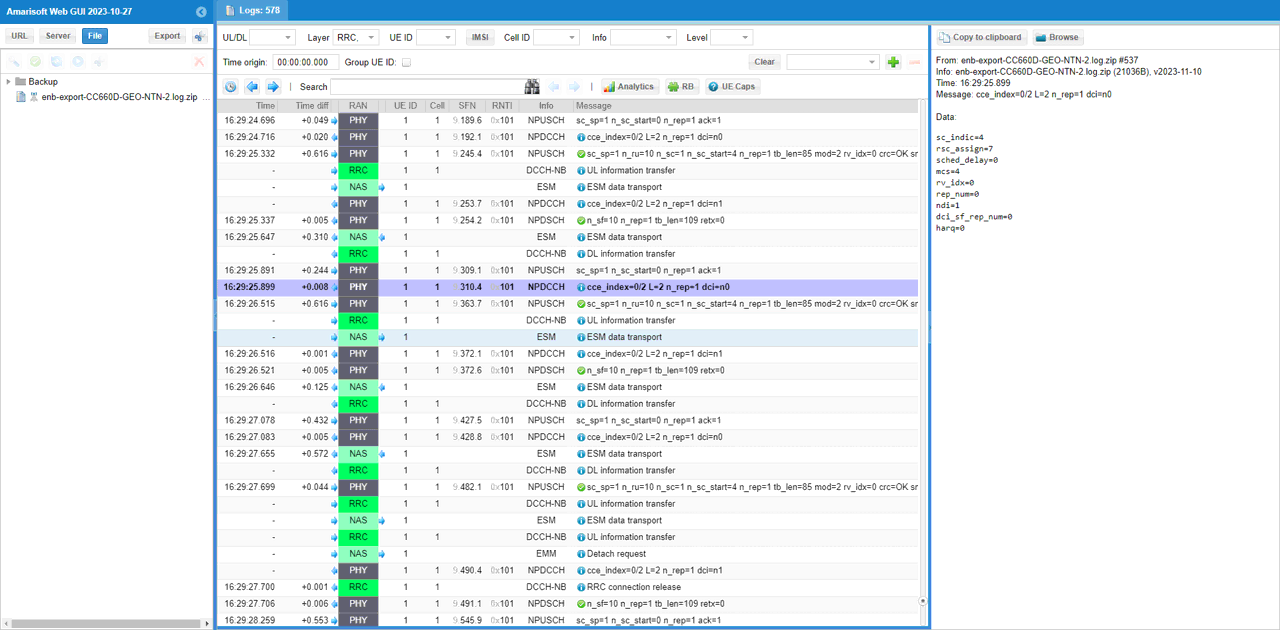
RRC / NAS Signaling
SIB31 (LTE)
: This is SIB31 containing ephemeris
{
message c1: systemInformation-r13: {
criticalExtensions systemInformation-r13: {
sib-TypeAndInfo-r13 {
sib31-v1700: {
servingSatelliteInfo-r17 {
ephemerisInfo-r17 orbitalParameters: {
semiMajorAxis-r17 8394210402,
eccentricity-r17 0,
periapsis-r17 0,
longitude-r17 242097885,
inclination-r17 0,
anomaly-r17 177192
},
nta-CommonParameters-17 {
nta-Common-r17 7776350
},
ul-SyncValidityDuration-r17 s240,
k-Offset-r17 1023
}
}
}
}
}
}
FAQ
I am putting a list of frequently asked questions and answers that would help everybody.
[Q1] why we need channel simulator ?
[A1] It is necessary to simulate the constantly changing real time position of the satellite
[Q2] do we always need to use the channel simulator ?
[A2] Yes for MEO or LEO in which delay and doppler varies relatively in large scale. Maybe optional to GEO in which delay and doppler does not vary widely. (NOTE : You may use the internal channel simulator at the testing phase in quick and easy way, but you can also use an external satellite channel simulator as well).
[Q3] What is the maximum delay simulated by Amarisoft Channel Simulator ?
[A3] Up to several seconds. The maximum value will depend on the sample rate, the value is max_delay in s = 2.147e9 / (sample_rate in Hz). In NB-IoT, for example, the sample rate is usually 1.92 MHz, so the max_delay is around 1118 seconds.
[Q4] What is the minimum configurable altitude of a satellite ?
[A4] The 3GPP encoding for the semi-major axis has a minimum of 6500 km, so a minimum of 122(=6500-6378) km altitude, where 6378 is the radius of the earth
[Q5] For ue_position, ground_position, we allow the altitude with the range of -1000m to 20km, what is the reason to allow negative values ?
[A5] It is to configure altitude below sea level. (https://en.wikipedia.org/wiki/List_of_places_on_land_with_elevations_below_sea_level )